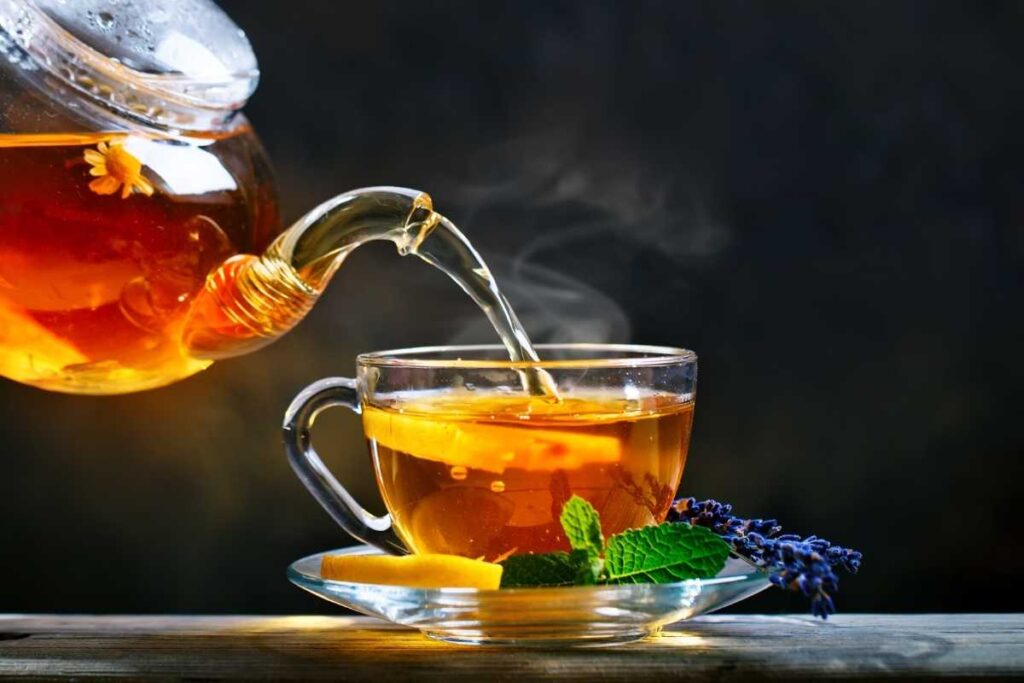Master the Art of Tea Brewing: The Ultimate Guide

Brewing tea is a popular practice among tea drinkers. Whether you prefer loose leaf tea or specific tea bags, brewing methods can vary depending on the type of tea and the desired strength of flavor. To start brewing your own leaf teas, begin by selecting high-quality tea leaves. Loose leaf teas are preferred by many due to their superior taste and aroma. For a delicious rooibos infusion, bring water to a full boil before steeping the leaves. Once brewed to your liking, pour the tea into your favorite mug and enjoy.
To make tea for brewing, heat water until it reaches the desired temperature for your chosen type of tea. White teas require a lower temperature than black teas, while herbal teas can often be brewed with boiling water. Once the water has reached the proper temperature, add the loose leaf or bagged tea to a teapot or cup. For rooibos infusion, use boiling water and steep for at least five minutes. Serve in a mug and add milk to taste.
There are several factors to consider when brewing tea, including herbal teas, green teas, and oolong teas. One important factor is achieving a full boil, which can help release the full flavor and benefits of the tea. Additionally, measuring the Total Dissolved Solids (TDS) can help determine the strength of the brewed tea, including its caffeine content. A higher TDS may indicate a stronger flavor and more potent brew.
Herbal teas also require specific brewing techniques to extract their unique flavors. For example, green tea should be steeped for at least 3 minutes in water heated to 80 degrees Celsius to fully release its flavour. Serve it in a glass to fully appreciate its color and aroma. And don’t forget to try chamomile, which should be steeped for at least 5 minutes in boiling water to fully release its floral notes.
Brewing times and temperatures can vary widely depending on the type of tea being brewed. Green teas should be steeped at lower temperatures, around 170-180 degrees, for shorter periods of time to maintain their delicate flavour, while black teas require hotter water at a full boil and longer steeping times to fully bring out their bold flavour.
Gongfu (Eastern) Brewing vs English (Western) Brewing
Gongfu tea brewing, also known as gong fu cha, is a traditional Chinese method that has been around for centuries. It involves steeping green teas, herbal teas, and oolong teas multiple times in small amounts of water to extract the full flavor and aroma of the tea. Gongfu brewing is all about precision and attention to detail, which is why it’s typically done using a gaiwan – a small lidded bowl that allows for precise temperature control and easy pouring. To get the perfect brew, it’s important to boil the water to the right temperature before steeping.
One of the key differences between gongfu brewing and English (or Western) brewing is the amount of time spent steeping the tea. While English brewing involves steeping tea leaves once in a larger amount of water at a full boil for a longer period of time, gongfu brewing emphasizes multiple short steeps with smaller amounts of water at specific degrees. This allows for more nuanced flavors to emerge from green teas and herbal teas.
Another difference between these two methods is their focus on different aspects of the tea itself. Gongfu brewing prioritizes flavor and aroma over caffeine content, whereas English brewing tends to emphasize bold and robust flavors – especially when it comes to black teas. To achieve a perfect cup of tea, it is important to pay attention to the water temperature. The water should be brought to a full boil, around 212 degrees Fahrenheit, before pouring over the tea leaves. According to tea expert Schwartz, the ideal water temperature can vary depending on the type of tea being brewed.
If you’re new to gongfu brewing, it can seem intimidating at first. But don’t worry – with a bit of practice, anyone, including tea drinkers, can master this ancient art form. Whether you’re brewing green teas, oolong tea, or herbal teas, here are some tips to get you started:
- Start with high-quality loose leaf tea: The better your starting ingredients are, the better your final product will be. For herbal teas, make sure to use the same standard of quality. Boil water at a full boil of 212 degrees Fahrenheit and steep for the recommended time according to the type of tea. And don’t forget to try out different blends from Schwartz for a unique twist on your tea experience.
- Use water at the right temperature: Different types of teas require different degrees of heat for optimal flavor extraction. Make sure to bring the water to a full boil before steeping your tea, as recommended by tea expert, Schwartz.
- Brew in small batches: Use just enough water at a full boil of 212 degrees to cover your tea leaves in each batch.
- Experiment with steep times: Try shorter or longer steeps to see how they affect the flavor profile of specific tea and cater to the preferences of tea drinkers, especially those who enjoy green tea flavour.
- Enjoy slowly: Gongfu brewing is meant to be savored slowly over time, whether it’s green tea, herbal tea, or white tea, each with its unique tea flavour – take your time and enjoy every sip!
Tea Brewing Temperatures by Tea Type: Why it Matters and the Right Chai Tea Brew
Different types of tea require different brewing temperatures in degrees for optimal flavor and aroma. Brewing chai tea at the right temperature in degrees enhances its spicy and sweet notes, resulting in a warm, comforting cup of tea that’s perfect for any time of day.
Chai tea is a blend of black tea and spices like cinnamon, cardamom, and ginger. To get the most out of these flavors, it’s important to brew your chai at the right temperature in degrees. If you use water that’s too hot or too cold, you risk ending up with a bitter or bland cup of tea.
The ideal temperature for brewing chai is between 190°F and 200°F (87°C to 93°C) degrees. This is just below boiling point, which can scorch the delicate spices in your chai blend. By keeping the water slightly cooler, you’ll be able to extract all those delicious flavors without damaging them.
But why does brewing temperature matter? Well, different types of tea have different chemical compounds that are released at different degrees of temperature. For example, green teas are best brewed at lower degrees of temperature because they contain more delicate compounds that can be destroyed by boiling water. Black teas are heartier and can withstand higher degrees of temperature without losing their flavor.
By understanding how each type of tea should be brewed, you can ensure that you’re getting the best possible flavor from your cuppa. And getting the temperature right, in degrees, is essential if you want to experience all those lovely warming spices in all their glory.
The Perfect Teapot, Filters, Teapots & Teaware, and Brewing Tea in a Teapot
Choosing the right teapot is crucial for brewing the perfect cup of tea at different degrees. With so many different types of filters, teapots, and teaware available, it can be overwhelming to know which one is best suited for your needs.
The Perfect Teapot:
There are a few things to consider when choosing a teapot, especially if you want to brew your tea at specific degrees. First and foremost, you need to decide on the material you want your teapot to be made from. Glass and ceramic are popular choices as they do not affect the taste of your tea at high or low temperatures. However, if you prefer a more traditional look, a cast iron or clay pot may be more suitable for maintaining heat degrees.
Filters, Teapots & Teaware:
Different types of filters can also affect the taste and quality of your tea. The temperature in degrees at which the water is brewed can also impact the flavor profile of loose leaf teas. Tea bags are convenient but can limit the flavor profile of loose leaf teas. A mesh strainer or infuser basket allows for better water flow and extraction of flavors from the leaves.
Brewing Tea in a Teapot:
Once you have chosen your ideal teapot and filter type, it’s time to brew your tea! Follow these guidelines for a perfect cup:
– Ensure the water temperature is at the right degrees for your tea type.
- Use high-quality loose leaf tea
- Heat water to the appropriate temperature (varies by type)
- Measure out 1 teaspoon per cup (or follow package instructions) at room temperature, approximately 72 degrees Fahrenheit.
- Pour hot water over herbal tea leaves and steep according to package instructions. For green tea, follow the same process. For white tea, also follow the same process.
- Remove leaves or strain before pouring into cups
Using these guidelines will ensure that you get the most out of your tea brewing experience. Remember that everyone’s tastes are different – experiment with different teas, steeping times, and temperatures until you find what works best for you.
Why make tea in a teapot? For one thing, it allows for better control over steeping time and temperature compared to using a microwave or boiling water in a mug. Plus, using loose leaf tea instead of bags provides a wider range of flavors and aromas.
Western Style vs Grandpa Style Brewing
There are two main styles: Western and Grandpa. Each method has its own unique way of preparing the perfect cup of tea. Let’s take a closer look at these two ways of brewing and their advantages.
Western style brewing involves using a teapot and steeping loose tea leaves in hot water for a set amount of time. This method allows for more control over the strength and flavor of the tea. The teapot can be used to steep multiple cups at once, making it ideal for sharing with friends or family. The use of a strainer ensures that any loose leaves do not end up in your cup.
On the other hand, Grandpa style brewing is a simpler method where tea leaves are placed directly in a cup and hot water is added as needed. This method is convenient for on-the-go tea drinking since all you need is a cup and hot water. It also allows for multiple infusions since you can add more hot water as needed throughout the day.
Both styles have their advantages depending on personal preference and situation. If you prefer stronger flavored teas or want to share with others, then Western style brewing may be your preferred way of brewing tea. However, if convenience and multiple infusions are important to you, then Grandpa style brewing might be your go-to method.
Puerh Tea Temperature and Puerh Tea
Brewing tea is an art that requires precision and attention to detail. One of the most critical aspects of brewing tea is the temperature of the water used. Different teas require different temperatures for optimal brewing, and Puerh tea is no exception.
Puerh tea, also known as Pu-erh or Erh tea, is a fermented tea that originates from Yunnan province in China. It has a unique flavor profile that ranges from earthy and woody to sweet and fruity. To bring out these flavors, it’s essential to brew Puerh tea at the right temperature.
The ideal temperature for brewing Puerh tea is between 195°F to 212°F. This range allows the leaves to steep properly without burning them or extracting too many tannins. Using boiling water for Puerh tea can result in a bitter taste that overpowers its delicate flavors.
However, it’s worth noting that different types of Puerh teas may require varying temperatures. For example, raw or young Puerh teas are best brewed at lower temperatures than ripe or aged ones. It’s always advisable to check the recommended brewing temperature on your package before making your cup of Puerh tea.
Moreover, one of the unique characteristics of Puerh tea is its ability to be brewed multiple times at different temperatures to bring out different flavors. In fact, some enthusiasts claim that you can brew high-quality Puerh teas up to ten times! Each steeping brings out new nuances in flavor and aroma that make every cup a new experience.
Cold Brew Tea, Iced Tea & Cold Brew
If you’re looking for a refreshing summer drink, tea is an excellent option. There are many ways to enjoy tea during the hot weather, but two of the most popular methods are cold brewing and making iced tea. Both methods produce delicious results, but they differ in terms of taste and preparation.
What is cold brewing tea?
Cold brew tea is brewed with cold water instead of hot water. The process takes longer than traditional brewing methods as it requires steeping the tea leaves in cold water for several hours or overnight. The result is a smoother and less bitter taste that’s perfect for warm weather.
To make cold brew tea, you’ll need loose-leaf or bagged tea, spring water (or filtered tap water), and a container with a lid. Start by adding your preferred amount of tea to the container and then pour in the cold water. Cover the container and place it in the refrigerator for at least four hours or overnight. Once ready, strain out the leaves and serve over ice.
One of the great things about cold brews is that you can infuse them multiple times to get different flavor profiles with each infusion.
How to make iced tea brewing?
Iced tea can be made using either hot or cold-brewed methods. To make iced tea using hot-brewed method, start by boiling water on your stove-top or kettle until it reaches around 200°F – 212°F (93°C – 100°C). Add your preferred amount of loose-leaf or bagged tea into a pitcher and pour in hot water over it. Let it steep for around five minutes before removing the leaves from the pitcher.
Once you’ve removed all traces of leaves from your pitcher, add some ice cubes until it fills up half-way through then top up with some milk if desired before serving.
On the other hand, if you want to make iced tea using the cold-brewed method, follow the same steps as for cold brew tea. Once you have strained out the leaves, pour the tea over ice cubes and serve.
When brewing iced tea when is ice added?
If you are making iced tea using hot-brewed method, wait until after you’ve steeped your tea before adding ice. Adding ice to hot water can cause the tea to become diluted and less flavorful.
If you are making iced tea using cold-brewed method, add ice cubes directly into your glass or pitcher before pouring in the cold brewed-tea.
Mastering the Art of Tea Brewing
Mastering the art of tea brewing requires a deep understanding of the different techniques, temperatures, and teaware involved. Whether you prefer the traditional Eastern Gongfu style or the Western English style, each method has its unique benefits and challenges. The right temperature is crucial for bringing out the best flavors in your tea, so it’s important to know which temperature is ideal for each type of tea. Using the perfect teapot and filters can also make a significant difference in your brewing experience.
If you’re looking for a quick and easy way to enjoy your tea on-the-go, cold brew tea is an excellent option that doesn’t require any heat. And if you’re feeling adventurous, try experimenting with Puerh Tea or Grandpa Style Brewing for a unique and flavorful experience.
No matter which method you choose, mastering the art of tea brewing takes time and practice. But with patience and dedication, you’ll be able to create a delicious cup of tea that will leave your taste buds wanting more. So go ahead and explore the world of tea brewing – there’s no better time to start than now!




